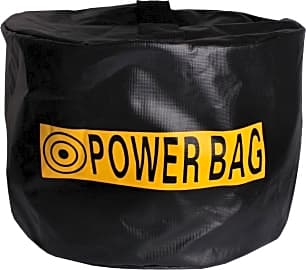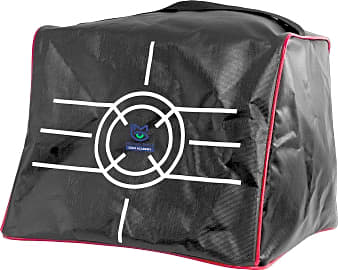The 7 Best Golf Impact Bags

This wiki has been updated 37 times since it was first published in December of 2016. Maintaining your swing all year long has never been easier, thanks to these highly effective golf impact trainers. These smash bags help you develop the proper technique for improving distance and accuracy by building muscle memory through repetition. The result is a powerful and consistent stroke — and less time spent in hazards — every time you decide to hit the course. When users buy our independently chosen editorial choices, we may earn commissions to help fund the Wiki.
Editor's Notes
March 01, 2019:
We wanted to love the Golfing Machine 3-D, we really did. It has an innovative design that enables you to attack your game from different angles; however, this just wasn't enough to justify the high price point. Beyond that, the fact that it comes pre-filled means that you can't customize the firmness to your liking. The ProActive Sports Contact, on the other hand, has several small features we appreciated, including a ground stake loop that prevents you from having to chase the thing all over the driving range.
The Many Benefits Of Training With Golf Impact Bags
Impact bags are also great for keeping your swing in tip top shape throughout the winter months when it may be too cold to go to the driving range or hit the links.
Golfing isn't exactly the easiest sport, so anything that can help you add a few extra yards to your shot should be a welcome addition to your gear. Golf impact bags are one such accessory. Not only can they increase your shot distance, but they can also help correct common swing issues most golfers face. As an added benefit, they are also very reasonably priced, so they won't stop you from buying that brand new approach wedge you've been eyeing.
Let's take a look at how exactly an impact bag helps to improve your golf swing. One of the main things it does is help return your focus to arguably the most vital aspects of a golf swing — the impact. Maintaining your focus on the moment of impact during your golf swing can help you minimize — or even better eliminate — casting and increase clubhead lag, which is vital to improving shot distance. Clubhead lag happens when the angle of the shaft and the left arm (or the right arm depending on your dominant hand) is maintained all the way from the top of the backswing into the downswing.
One of the reasons most golfers don't attain proper clubhead lag is because they tend to drive into the impact with their whole body, rather than throwing their hands and wrist at it. Another reason is because they swing as if the ball is their target instead of trying to power through it. Unfortunately, it is very difficult to practice improving clubhead lag using an actual golf ball unless a player maintains a high level of focus on their motions the whole time. Luckily, a golf impact bag naturally trains you to swing through the spot of impact, even if your mind is concentrating on other concerns.
Impact bags are also great for keeping your swing in tip top shape throughout the winter months when it may be too cold to go to the driving range or hit the links. They don't require nearly as much space as an indoor golf simulator or practice net, nor do they cost an arm and a leg like the former.
How To Use A Golf Impact Bag Properly
As with any training aid, a golf impact bag won't help much unless you know how to use it correctly. It's also important to understand what you should be aiming for, so let's start with an explanation of the proper body position you want to attain at the moment of impact. This body position description is for right-handed golfers. If you are a leftie, everything is reversed. As your club makes contact with the ball, roughly 75 percent of your weight should be on your left foot, with your hips rotated to the left and turned towards your target. Your right heel should be in the process of lifting off the ground with the foot starting to rotate onto the instep.
Your focus should be on having your club shaft making the first contact with the upper right corner of the bag.
Your left arm should be almost completely straight and fully extended down the front left side of the body, with the hands just in front of the left thigh. The handle of the club should stay further to the left than the clubhead throughout the entire swing. This body position will help your body generate the maximum amount of power, giving your ball plenty of distance.
Start by placing the bag opposite your left foot. Now practice swinging your club away from the bag, then returning to it with your hips rotating to the left of their starting position as you make impact. You should also focus on moving the majority of your weight onto the left foot as you do this and creating a straight line from your left shoulder down through the club shaft and into the head as you make impact. As long as the bag is placed opposite and inline with your left foot, this straight line should be created naturally.
Another way to train with an impact bag is to place it in a vertical position in the center of your stance. Imagine you have a golf ball in the normal position opposite your left foot. Swing down at the bag, rotating your hips to the left as you do, as if you are striking the imaginary ball. Your focus should be on having your club shaft making the first contact with the upper right corner of the bag. If your shaft hits the bag first, it means you are achieving a good amount of clubhead lag. On the other hand, if you clubhead strikes the bag first, it means you are making a flicking action with the club, which results in hitting the top of the ball and making weak shots with little power behind them.
Golf Through The Ages
We find evidence of golf-like games being played as many as 1,000 years ago. For example, during China's Song Dynasty, there was a popular game called chuiwan, in which players would hit balls into holes using a set of wooden clubs. Much like in modern-day golf, these holes were marked by flags to make them easier for players to see from afar. Historians have also found record of the Dutch playing another golf-like game in the 1300s. Despite this, Scotland is the country officially credited with inventing golf sometime in the 15th century. Not long after its inception though, King James II banned the game, as he felt it detracted Scotsman from practicing the more utilitarian pursuit of archery. Less than 55 years later, one of his direct decedents, King James IV, being an avid golfer himself, decided to lift the ban.
The oldest still surviving set of standardized golf rules were written by the Honourable Company of Edinburgh in 1744, which are now referred to as the Leith Rules. After golf's first Open Championship took place in Ayrshire, Scotland 1860, it soon spread across the Atlantic, with America's earliest country clubs opening toward the latter end of the 19th century.
Over the years, golf's popularity has gained and waned at different times, peaking in the early 2000s with an estimated 31 million active players. Today, that number stands at closer to 25 million.












